Farali Aloo Sabudana Papad or Potato Sago Papadum are easy 5 ingredients papadams made using potato, sago seeds and a few spices. These papads do not need any fancy gadgets to make and are preservative-free. They are perfect as a side on your thali or best for your fasting/vrat or upvas days.

This post may contain affiliate links· Please read our Privacy Policy for details. You can jump to the recipe, but you will miss the tips and tricks mentioned in the post
These papads are generally made during the summer months. They are then sun-dried and stored. One can fry them in deep oil or if you prefer oil-free papads it is best to roast them on an open flame or microwave them.
Summers, papad and fun
Papads and summers go hand in hand. And making papad, aloo wafers, mangodi, pickle during summers is fun and makes me nostalgic. Have loads of memories making them as a child and while I was in India along with my mother. I always made this along with her or use to just bring it along.
However, I always wanted to make it. But the weather in Ireland is not that good to do. However, the current situation gave me an opportunity to make this at home. So last year I made some different types of papads and wafers. I experimented a lot too. For a few, I do not even remember the recipes I made, but hopefully, I will retry them and share them soon.
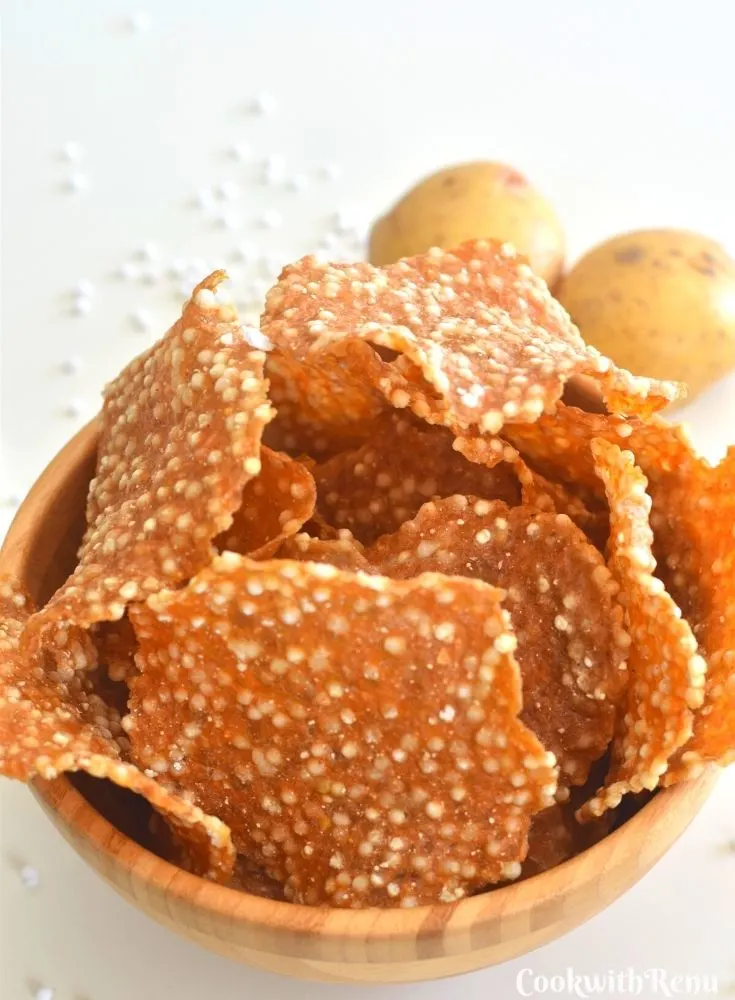
Farali Papad
As said earlier, this papad can also be called Farali papad or Farali Aloo Sabudana papad as they use all the ingredients that can be consumed during fasting or vrat days. One can use sendhav salt instead of regular salt if especially making for fasting.
I generally like to make this along with my fasting thali or along with Samak Rice Khichdi. These papads also go well with everyday meals like Jeera Rice, or Khichdi or simple everyday Lunch thali.
Recipe process of Farali Aloo Sabudana Papad
The recipe for this Aloo Sabudana Papad is very simple. All you do is soak the sabudana the previous day. Basically, we need the sabudana or sago seeds to soak and swell nicely. So a good overnight soak or best to soak for 8-10 hours minimum. Then you need boiled potatoes, red chilly powder, salt and cumin seeds. That’s it. One needs to mix everything and roll it out.
Variations to this Aloo Sabudana papad
You can add green chilly paste, garlic and ginger paste. Last year I made them with green masala as well. I.e. I added green chilly paste, ginger paste and coriander instead of red chilly. They tasted equally good. The coriander added flavour and taste. Keep the ingredients in mind if you are making it only for fasting.
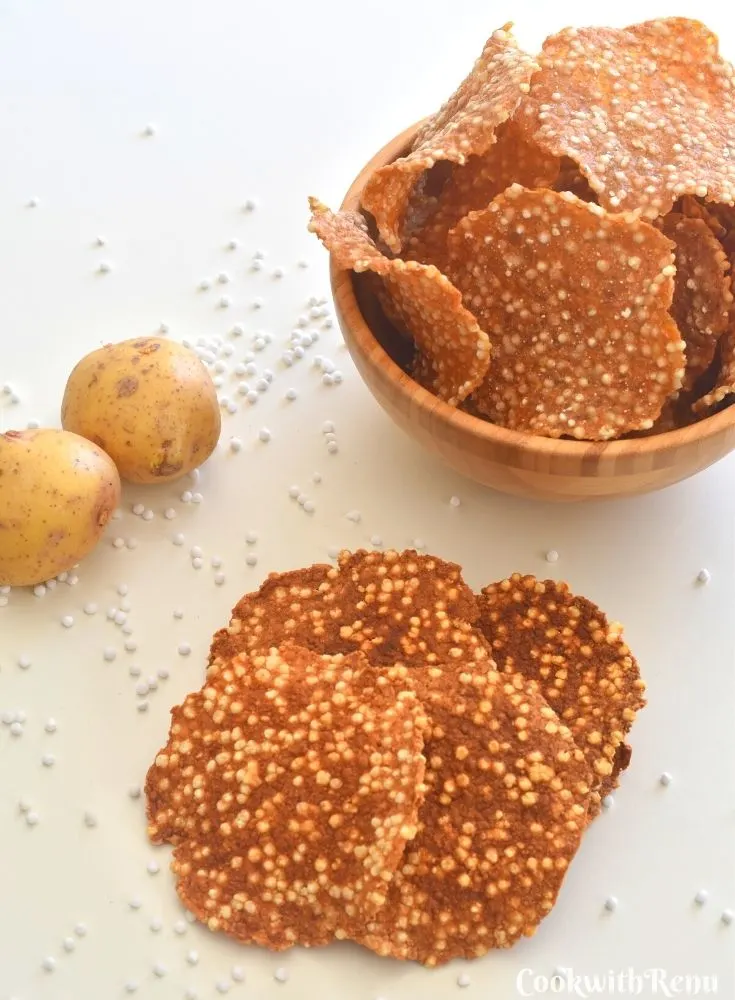
Using whole Sabudana Seeds or Sabudana Flour/Powder
Soaked sabudana is used directly here. I am not making a powder of this sabudana or using Sabudana Flour. I like the little crunch the sabudana gives here. But you can make flour or powder of sabudana and use it as well. In that case, one need not soak the sabudana. Just roast it a bit and grind it in a mixer grinder. Rest the process is similar.
Rolling of Aloo Sabudana Papad
One can roll this papad in multiple ways.
- A papad maker or a roti maker to make papads
- Using a rolling board and pin
- Lastly, one can flatten them using a medium-size pot or a cylindrical disc or plate.
As I have a roti maker which I never used to make roti, but I love to make papad or Pani puri from this. So putting it to good use. So in either of the three ways mentioned above, All you do is, take a lemon size ball of the mixture. Keep the ball in between two greased plastic sheets and roll it/flatten it or press it.
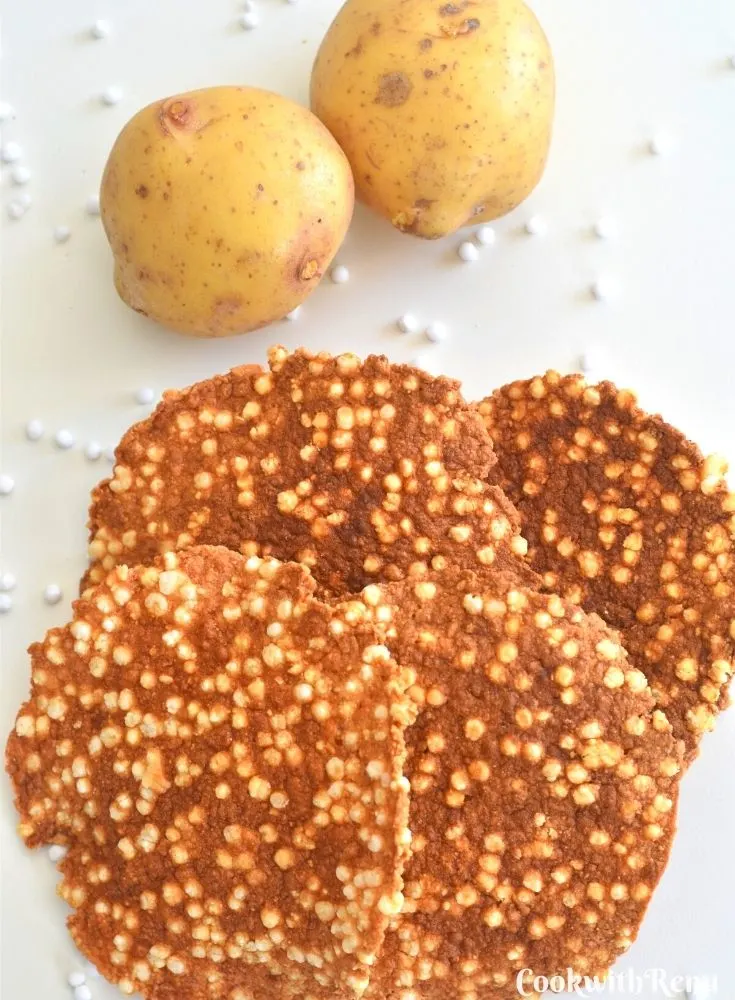
Sun-Drying of Aloo Sabudana Papad
It is best to sun dry these papads. So after rolling you lay them on a big plastic sheet or a big clean cloth. Let them sundry the whole day, turning mid-afternoon. It is best to start the process of making these papad’s early in the morning, so you take the advantage of full sun for the day and you are not even sun-burned if you start early.
After day one you would need to dry them for 2-3 days more in sun. This helps to remove any excess moisture in them and dry them completely. Then you store them in a clean air-tight container.
Options for Drying
One can dry this papad at home without Sun too. But you would need to keep the fan on. Which I do not suggest, as It does waste energy. But if you have no option and want to make this you can do this. You would need to make sure that they are dried completely before storing them.

Cooking Farali Aloo Sabudana Papad
Once they are dried completely, one can fry them in hot oil. If you do not prefer frying, roast them on an open flame. The slightly burnt taste from aloo(potato) makes them really tasty. Alternatively one can even microwave them for a min. So in all, you can even consume this completely oil-free and in a healthy way.
How to Fry Papad in Oil
Heat the oil. Once the hot is oil, fry the papad for 30-40 seconds until brown on both sides. Do not over fry it or it will burn. As it has potato it gets fried or cooked faster. Drain excess oil and remove it on an absorbent paper or a strainer. Let it sit for a minute or two before consuming.
Once fried they can be stored in airtight container for 10-15 days
How to roast Papad on an open flame
Roast the papad on medium to fast flame. Hold the papad in between tongs and roast them turning the sides and roasting evenly on both sides.
How to roast Papad in the microwave
Microwave the papad on high for 1 minute, turning in between after ½ minute.
Type of Potato Used
In India generally, the potato available in the month of April and May month is used to make these papads. The potato is available in abundance and cheap during this month as well they are the best to use for papads. Here in Ireland, we have loads of varieties. I like to use white potatoes instead of the rooster variety. The rooster variety is dry and I do not prefer that.
Recipe Quantity
The recipe can be doubled or increase to 5 times. I am sharing a small batch with 1 kg as I make it in small batches of 1 or 2 kgs. With limited space, little help from my kids and time constraints, I make small batches. But if you have space and time, you can easily make in large batches.
Few Things to take care of / Pro-tips
- The papads should be thoroughly dried. If there is some moisture or they have not dried properly, they will go bad. You would have mould or fungus.
- While storing, make sure the box you use is completely clean, dry and sterile and free from any moisture.
- It is always advisable to use an air-tight container.
- While storing them make sure your hands are clean and dry as well.
- Any moisture or water content will decrease its shelf life.
- Use clean plastic sheets/cloth for rolling and drying.
Weather
Weather is very crucial while making this. In India, you need not worry during April and May months, but if you are at places where it can rain anytime you would need to check the weather before. You need a good 4-5 days of sunny weather before making any papad or wafers. So do keep that in mind.
Shelf life of papad
If everything is followed correctly, the papad’s stay good for a couple of years. However, we make it only for 1 year. The next year we can always make fresh. The pic shows the papad I have made last year. I have yet to begin this year and waiting for some good weather.
I think I have covered all the tips and tricks, if you still have questions do let me know in the comments below.
YouTube Channel
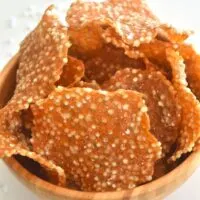
Recipe of Farali Aloo Sabudana Papad ( Potato Sago Papadum)
Equipment
- Plastic Sheets
Ingredients
- 1 Kg Potato
- 1 cup -180 grams – Sabudana seeds -Sago
- 1 tablespoon Cumin seeds
- 1 tablespoon Red chilly powder -More or less can be added
- Salt to taste – one can use Sendhav Salt if making especially for fasting.
For Rolling
- 2 medium-size plastic sheets
- 1 tablespoon oil
- Rolling pin & Board / Papad Maker or Roti Press / Medium size pot or a round plate or disc
For Drying
- A big Plastic Sheet / A big size cloth
Instructions
- Clean the Sabudana for any impurities.
- Rinse the sabudana in water and drain all the excess water.
- Now add just enough water. I.e. add water around ⅛ inch above the sabudana. I.e. there should just be a single ⅛ inch layer of water. (After 1 hour if you check, all the water must have been absorbed. If not, and if you have added excess water, just discard the water from the top)
- Soak the sabudana well for 7-8 hours or overnight.
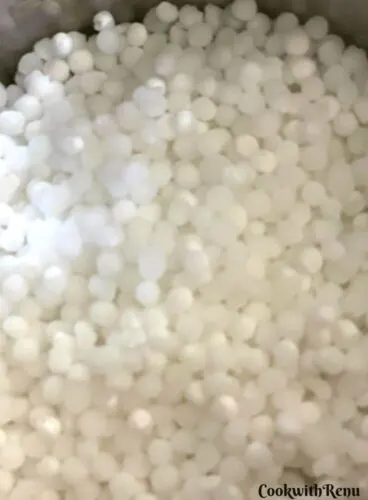
- Next morning Boil the potatoes in a pressure cooker / Instant Pot or open pot as you prefer. (Can be done earlier day too)
- Let them cool completely.
- Once cooled, peel the potatoes and grate them using a fine or a box grater.
- Add the soaked sabudana, red chilly powder, cumin seeds, and salt.

- Give everything a nice mix.

Rolling and Drying of Papad
- Divide the dough into lemon size balls.
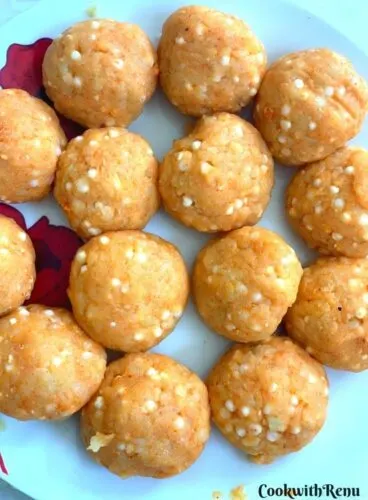
- With little oil in between your hands roll them to a smooth ball.
- Grease two plastic sheets.
- Keep one plastic on the rolling board or papad maker, grease side up
- Keep the papad dough ball on top.

- Now cover it with another plastic sheet, grease side down now.

- If you are using a roti maker or papad maker, simply press it to make a circular disc or papad.
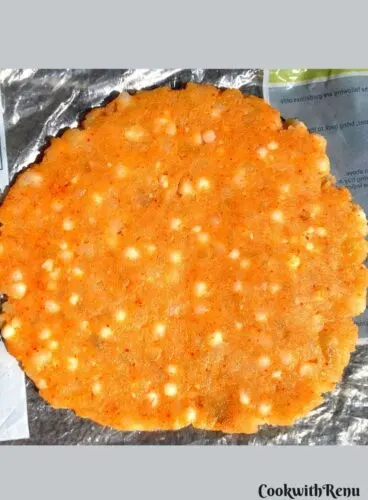
- Roll it evenly if using a rolling pin and board.
- If using a circular plate/pot or a disc, press it from the top by applying little pressure.
- Using any of the above methods, try to roll the papad evenly.
- Arrange the rolled papads on a big sheet or a cloth, keeping enough space in between.

- Let it sun dry the whole day.
- Turn the papad’s mid-afternoon upside down, when you see the top getting a bit dry.
Drying of Papads
- In the evening collect all the papad’s and let it dry in open the whole night.
- The next morning let them sun-dry again for the whole day. While drying see to it that all the papads are getting a good amount of sun.
- Repeat the above process for 3-4 days until the papads are dried completely.
- Once done, store it in an air-tight container.
How to Fry Papad in Oil
- Heat the oil. Once the hot is oil, fry the papad for 30-40 seconds until brown on both sides. Do not over fry it or it will burn. As it has potato it gets fried or cooked faster. Drain excess oil and remove it on an absorbent paper or a strainer.
How to roast Papad on an open flame
- Roast the papad on medium to fast flame. Hold the papad in between tongs and roast them turning the sides and roasting evenly on both sides.
How to roast Papad in the microwave
- Microwave the papad on high for 1 minute, turning in between after ½ minute.
Notes
- Do read the tips and tricks mentioned above for rolling and sun-drying the papads.
- Do follow hygiene and all tricks for the best results.
- If sun-drying is not an option one can dry at home too.
- I have detailed above in the post.
- I reuse the plastic sheets that come in different dals and pulses.
